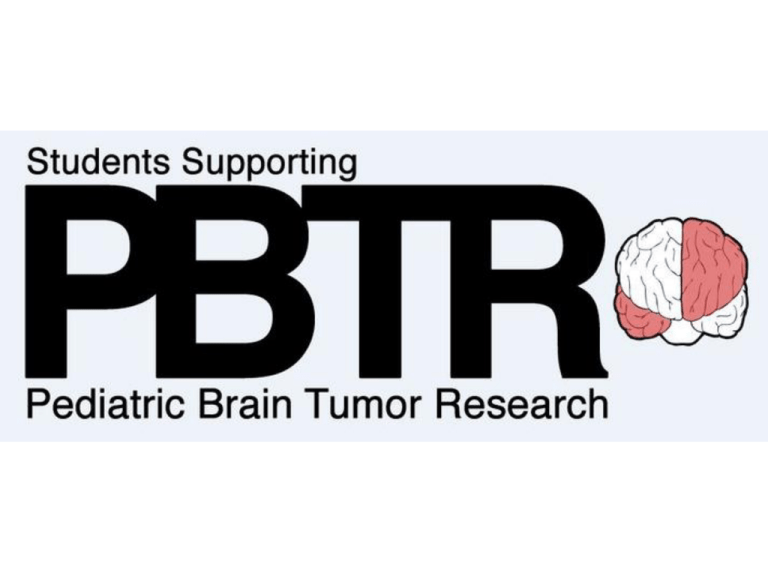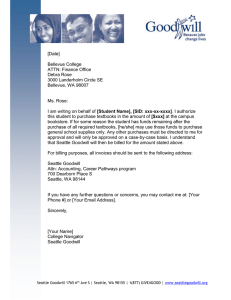Document 15692862
advertisement

Overview • Group Introduction • Our Cause: – Meeting a Community Need • • • • Goals and Mission Statement Communication Methods Final Project Summary Students Supporting Pediatric Brain Tumor Research is: Student Names Our Cause: to raise money and awareness for …helping to improve the odds for so many children! Run of Hope Seattle for the Pediatric Brain Tumor Research Fund Run of Hope Seattle is a 5k run / 3k walk event that takes place on September 25, 2011 in Seward Park. Its purpose is to raise money for scientific research of pediatric brain tumors and potential treatments. Run of Hope delivers 95% of all proceeds to the Pediatric Brain Tumor Research Fund. Group Goals and Mission Statement In order to develop a group project with a successful outcome, we devised a list of achievable goals and developed a strong mission statement. Goals Reach out to the community via electronic media to raise awareness for pediatric brain tumor research Meet biweekly and email/correspond weekly Contact 80 companies to obtain corporate sponsorships Reach 30 Facebook friends According to Beebe and Masterson “…a team should have a clear and elevating goal (Communicating in Small Groups, Principles and Practices; pg 106).” Define Goals > Create a Mission Statement Beebe & Mastersons’ SMARTS Test (Communicating in Small Groups, Principles and Practices; pg 106) • • • • • • S: Specific Goal (what do you wish to accomplish?) M: Measurable Achievement (can you gauge progress?) A: Attainable (is the goal realistic?) R: Relevant (does the goal meet needs?) T: Time Bound (can it be completed in the allotted time?) S: Stretch the Team (does it challenge you?) Our Mission Statement: Students Supporting Pediatric Brain Tumor Research is comprised of concerned individuals that have come together with the goal of raising community awareness and obtaining corporate sponsorship for Run of Hope, which raises funds for pediatric brain tumor research. Practices of Dialogue Like the inner-workings of a clock, the four main practices outlined in William Isaacs’ Dialogue need to be used together in order to create a flowing dialogue. “When you express them together, you experience balance, resilience, strength, life. When one or more are absent, conversations are less whole, less effective – they feel dead” (80). Keeping these principals in mind, our group was able to be effective by: 1) listening not only to ach other, but to ourselves as well, 2) respecting each other and honoring each other’s boundaries, 3) suspending our opinions and being open to others, and 4) speaking up and accepting each other’s voice. Group Meetings Students Supporting Pediatric Brain Tumor Research group members utilized many virtual spaces to conduct meetings when we were unable to meet face to face. We emailed one another frequently to conduct group conversations, assign tasks, and check progress. We also used the free internet calling service Skype for live teleconference meetings, which we scheduled in advance and took turns facilitating according to the guidelines in Facilitation at a Glance! Our Pocket (sized) Protector Students Supporting Pediatric Brain Tumor Research group members relied on Chapter 7, Meeting Management, to organize our electronic and teleconference meetings. The section titled Facilitating Teleconferences, beginning on page 130, was vitally important to our meeting process, as was the portion covering creation and sharing of meeting agendas. We found that without predetermined meeting agendas, our teleconferences were virtually (pun intended) impossible and readily adapted to using the Pocket Guide to help bring order and efficiency to our meetings. Communication within the Group about the Project In order to share ideas and information, Students Supporting Pediatric Brain Tumor Research group members used a web site called Evernote.com. It allowed us to post and share meeting field notes, distribute research findings, edit ongoing projects, and collaborate effectively in a collective workspace. All members could access works in progress and easily contribute to the project. Our Final Project Comes Together Through our group’s communication, cooperation, and collaboration, the pieces of our project came together to meet our end goals. Not only were we able to raise community awareness through Facebook and Twitter, we were also able to reach out to 80 companies asking for corporate sponsorships. May 30, 2011 Obtaining Corporate Sponsorship Our team decided to draft a letter that explained our mission and requested contributions to an event that raises funding for pediatric brain tumor research. Working with the organizers of the event, we were able to offer logo or company name placement on the event advertising and fundraising materials as incentive for potential donors, as a way for them to connect their business name to a worthy cause within the community. Dean Edith M. Wollin North Seattle Community College 9600 College Way North Seattle, WA 98103 Dear Dean Edith M. Wollin: Recently a small group of North Seattle Community College students joined forces to form Students Supporting Pediatric Brain Tumor Research. Our focus is to raise community awareness and obtain sponsorships for the Run of Hope Seattle; an event created by the Pediatric Brain Tumor Research Fund and Four Seasons Seattle. Brain tumors are the deadliest form of childhood cancer. Each year 3,750 children – 10 each day – are diagnosed with a pediatric brain tumor in the United States; 76 percent of these children are under the age of 15. Research that focuses specifically on pediatric brain tumors is crucial to saving these young children’s lives, and we are lucky to have an organization right here in our own backyard working hard toward that goal. The Run of Hope Seattle is a one-day event where family, friends, and community come together to raise funds and awareness in the battle against brain tumors. Since its inception in 2009, the Run of Hope Seattle has raised more than half a million dollars; 95% of which went straight to the Seattle Children’s Hospital and The Pediatric Brain Tumor Research Fund to fight against brain tumors. Our group is happy to be supporting the Run of Hope by reaching out to local businesses and asking for their assistance. As a highly regarded member of our community, we would like to ask for your support in the 2011 Run of Hope Seattle. In return for your generosity of $500 or more, The Pediatric Brain Tumor Research Fund and Seattle Children’s Hospital will display your company logo on the Run of Hope Seattle website, recognizing you for your charitable contribution to such a great cause. If you are interested in being a sponsor or just contributing a small donation to this amazing cause, please donate through Firstgiving at the email address link below. We will work with you to get your company information so to ensure your company is properly recognized for its contribution. DonationURL: http://www.firstgiving.com/fundraiser/studentssupportingbraintumorresearch/runofhopeseattle2011 We thank you in advance for your time and generosity. Sincerely, Ryan, Seren, Samantha, and Megan Students Supporting Pediatric Brain Tumor Research SPONSORSHIP REQUEST LIST Each group member was assigned to research twenty generous local businesses and health care providers to whom they submitted donation request letters. 24 Hour Fitness in Northgate A&M Imports in Bellevue Amber Restaurant Belltown Amore Infused Belltown Archestone Belltown Be Luminous Yoga South Lake Union Bean City Coffee Co Bellevue Kawasaki Bill Pierre Chevrolet in Lake City Bill Pierre Ford in Lake City BMW Seattle Café Ladro (Bothell) Café Ladro (Seattle) Capital Grille (Seattle) Capital Hill Flower and Garden CB Richard Ellis Chocolopolis in Queen Anne Clark Kjos Architects Culinary Essentials in Bellevue Ducati Seattle Eastside Motosports El Goucho (Seattle) Elliott Bay Medical Group Ferrari & Maserati of Seattle Flying Fish Restaurant South Lake Union Gene Juarez Northgate GLY Construction Gold’s Gym in Greenwood Greenlake Place Physicians Guitar Center in South Lake Union Harris Ford in Lynnwood Hilcrest Bakery Honda of Seattle Hot Yoga of Kirkland I Love Hot Yoga in Greenlake J Gilbert Footwear Belltown Jones Lang LaSalle La Belle Reve in Bellevue Forest Park Clinic Laurelhurst Family Medicine Lexus of Bellevue Margaret O’Leary U-Village Mercedes-Benz of Bellevue Midnight Blossom in Seattle Mithun Co. Mortenson Construction Nordstrom Northgate, Bellevue, Downtown North Seattle Community College Northwest Eye Surgeons NW Family Care Center Olympic Medical Center One Sky Wellness Associates Patrick's Fly Shop of Seattle Purple Restaurant Group Rainin’ Ribs BBQ & Smokehouse Retina Consultants of Seattle Rosaline Hampton Salon in Bellevue Ruth's Chris Steakhouse in Bellevue Seattle Healing Arts Seattle Seaplanes Sellen Construction Shiku Sushi in Seattle Sparta’s Pizza & Spaghetti House The Ballinger Clinic The Polyclinic (4 locations) The Sports Medicine Clinic Tumor Institute Radiation Oncololgy Group Turner Construction Upton Family Medicine UW Medicine Radiation Oncology (2 locations) ViaVita Cafe and Wine Bar in Bellevue Washington Motorcycle Road Racing Association What’s Next Media Seattle Wild Ginger (Seattle) Zimmer Gunsul Frasca First Giving Donations Page New corporate sponsors are directed to donate at Students Supporting Pediatric Brain Tumor Research’s First Giving web page. Raising Community Awareness With Social Media Facebook Page Our Facebook page was used to post updates, articles, and links to information about pediatric brain tumor research and Run of Hope Seattle. Our goal was to encourage participation in the event, increase donations, and spread the word about ongoing treatment research. Raising Community Awareness With Social Media Twitter Feed We created a Twitter feed to remind our followers to register for and donate to Run of Hope Seattle. In addition, it shares Tweets from the organizers of Run of Hope and Seattle Childrens’ Hospital. Project Summary • Achieved goals by meeting and communicating regularly • Overcame obstacles by relying on both teamwork and individual strengths • Learned how to communicate in group setting while overcoming apprehensions about working in groups • Helped raise awareness within the community for childhood brain tumor research The End Works Cited Beebe, Steven A., and John T. Masterson. Communicating in Small Groups: Principles and Practices. Boston, MA: Pearson/Allyn and Bacon, 2006. Print. Isaacs, William. Dialogue and The Art of Thinking Together. New York, NY: Doubleday, a division of Random House, Inc., 1999. Print. Bens, Ingrid, Dan Picard, and Carol Tornatore. Facilitation at a Glance!: a Pocket Guide of Tools and Techniques for Effective Meeting Facilitation. Salem, NH: Goal QPC, 2008. Print.
![[Date] Greg Tessensohn Special Accounts Coordinator](http://s2.studylib.net/store/data/015675580_1-3e5f32695dc54586c86ea10634c64bea-300x300.png)
![[Date] Greg Tessensohn Special Accounts Coordinator](http://s2.studylib.net/store/data/015675567_1-75efa0758facb1e763066c348ea5ad86-300x300.png)
